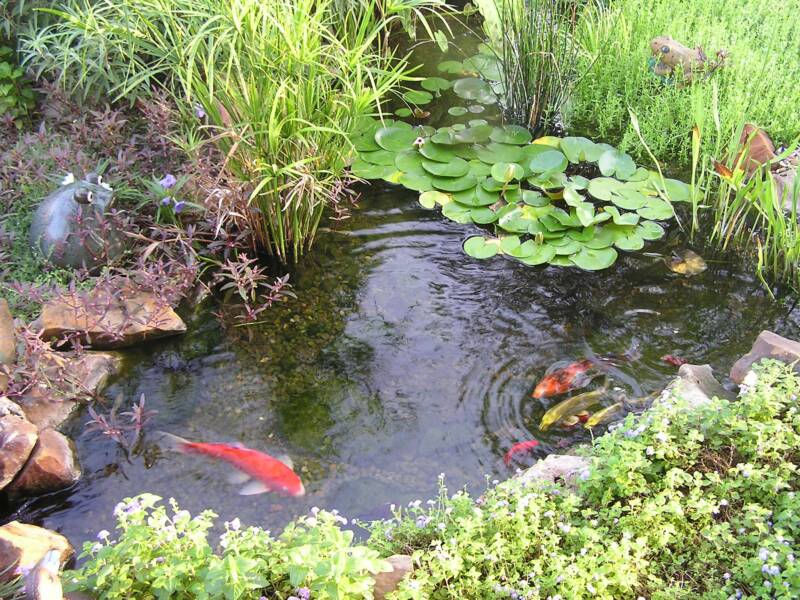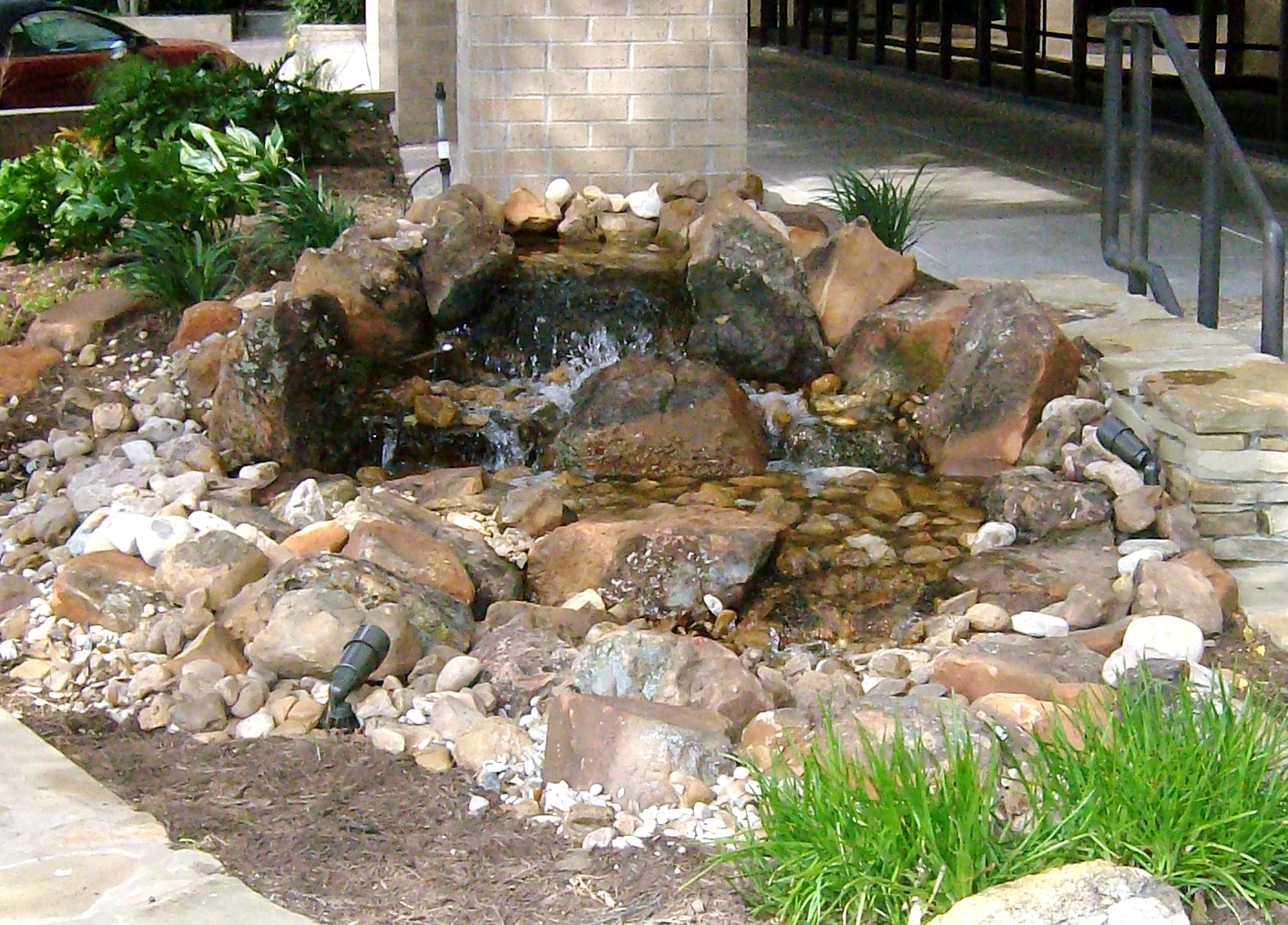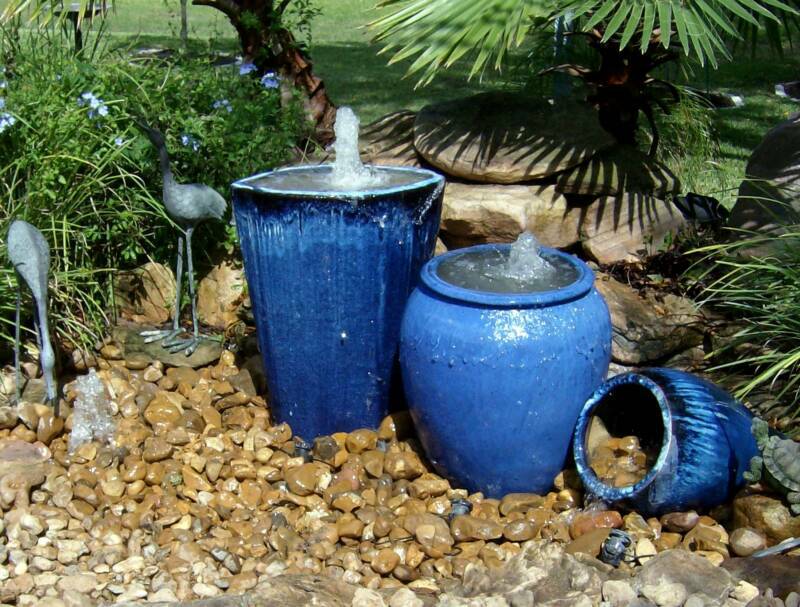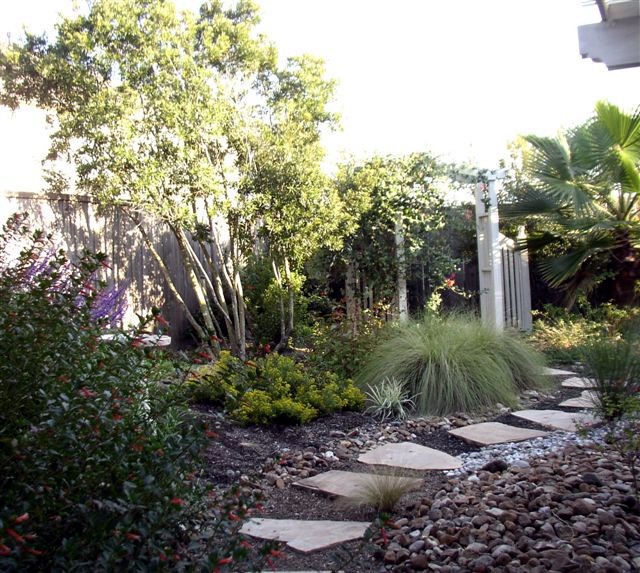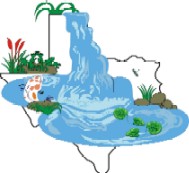


Rainwater Harvesting
Organic Ecosystem Ponds
Pondless Waterfalls
Urn and Fountain Features
Water-Wise Landscapes
Meet Your Water Feature Professionals


Texas Ponds and
Water Features
Dragonflies, Turtles and Frogs,
Oh My!
By Matt Boring
The Natural Water Gardener
“If you build it, they will come.” This famous line from a movie about baseball applies surprisingly well to what happens when you install a naturally balanced pond system in your yard. Frogs, toads, dragonflies, butterflies, birds, even the occasional turtles and salamanders will soon move into the area to take advantage of the new aquatic real estate. In other words, you never know who’s gonna show up. I’m consistently amazed that the variety of life that will take up residence in and around a backyard pond. It goes to show that the ecosystem doesn’t stop at the water’s edge. It continues outward and upward from the microscopic plankton that spend their whole lives in the pond’s water all the way up to migratory birds who may only stop once to get a drink and bathe in the stream on their way to unknown places far away. My customers have even had deer drinking from their backyard streams in unfenced areas outside Austin.
As undisturbed natural habitat disappears at seemingly ever-expanding rates, it becomes increasingly important for us as humans to give a little something back to nature or else risk losing some of our local wildlife species forever. Gardening organically and landscaping with native plants is a good start. The organic gardener and native landscaper believes in being a good steward to his or her part of the earth, helping to maintain some balance of nature while eliminating harmful runoff of fertilizers, pesticides and herbicides from their speck of land. To further encourage native wildlife in the area, water should be provided in some way whether it be in the form of a birdbath, fountain, or pond.
Ponds naturally draw frogs and toads to the area. Sometimes a family of frogs will take up permanent residence in your pond. I’ve seen up to three different varieties of frogs living in a single backyard water feature. They’re great swimmers, gliding underwater as easily and swiftly as the fish. And yes, it’s true that they’ll sit on your lily pads, floating on top of the water to get some sun and warm their bodies or to catch an insect that ventures too close. When you surprise them, you’ll see them jumping back into the water from all over the pond. Their gentle ‘ribbit, ribbit ribbit’ in the evening will take you back to those long-ago summer nights in the country.
Toads live on land but are drawn to the water to mate and lay eggs. Generally after dark you’ll hear them coming from all over the yard to converge at the pond’s edge. Their call is a bit more harsh than the frogs’ and they home in on each other with the sound. They are not good swimmers, seeming to doggy paddle across the surface of the pond, but must enter the water to lay their eggs. Their eggs look like long strings of clear goo with black dots in the strings. Frog eggs look more like a clump of clear goo with black dots in it. Within a few days, those black dots will be swimming around your pond. Watching them day by day, you’ll see their little legs emerge and their tail slowly disappear. Once they grow big enough, they’ll move out into the grass eating insects to sustain themselves and grow to full size. They’re quite effective at keeping unwanted bugs out of your yard and garden.
Dragonflies naturally flock to a body of water as well. If you’ve never had a pond, you’ll be absolutely amazed at how many colors in which they are found. I’ve seen them in black, black and white, black and yellow, orange, blue, green, blue with green heads, purple, maroon, and even bright red. I’d never seen a bright red dragonfly in my life until I started building ponds and now I’ve seen them at several of my water features. Dragonflies are voracious mosquito eaters and it’s good to have them around. You’ll see them in the evenings, skimming over the grass eating mosquitoes as the start to emerge. They also swoop down to the pond and flick the water with their thorax, although I don’t know why. It’s very entertaining though. They like to perch on vertical plants such as cattail, Iris, and some rushes. Like frogs and toads, dragonflies also reproduce using the pond. They mate in the air, the female lays her eggs in the water and the offspring hatch there, spending part of their lives in the pond as nymphs. When the time is right, they’ll crawl up one of those cattails, shed their skin, and like a butterfly, open their delicate wings for the first time. They have to sit still until their wings dry, but will soon venture off on their first test flight.
This year I finally saw some turtles in the pond. They were both red eared sliders. Turtles are naturally migratory so if they do show up in the pond, they probably won’t stay. Unless your pond is specially designed to keep the turtles in, they’ll likely leave you at some point, looking for that elusive greener grass on the other side of the fence. It’s very neat, however, to see an animal of this size in your water feature that you didn’t put in there. The first time I saw one in my pond, I ran in the house yelling, “Armando, we’ve got a turtle in the pond!” But the turtle had seen me and headed for the bottom and by the time we got back out there, he was well hidden.
In the mornings and late afternoons, the birds show up. Some of them bathe in the waterfall and stream area, opening their wings and splashing around insanely like energetic little kids at a hotel swimming pool. Others, such as mourning doves approach with more caution, feeding on the ground for a while, inching ever close to the water’s edge. They seem to be trying to sneak up on the pond, but are really just checking the area carefully before lowering their heads to take little drinks of water, then raising their beaks up to let it slide down their throats. Of course you’ll see different birds depending on where you live and depending on how much natural water they have access to in your area. This June was especially dry where I live and I saw many more birds than normal at my pond. It feels good to give nature a helping hand when you can.
By attracting and helping support the wildlife natural to your area, your backyard water garden becomes educational as well as entertaining. Those of you who are raising a new generation of nature lovers will enjoy endless opportunities to teach your kids about the circle of life by watching frogs, toads, and dragonflies mature in your pond right before your eyes. I’ve even known kids who named the various dragonflies that frequent their pond, recognizing them by their colors. You can also watch, photograph, and catalog the different species of birds that visit your pond or take up residence in your yard. One of my customers has been delighted this year to watch three baby owls growing up in the trees of her backyard. She even has a hawk that comes to bathe in and drink from her stream. By helping kids to understand the balance of nature in their own backyard, they can expand that understanding to the various ecosystems of the world and apply that balance to their own lives.
Because of the educational opportunities a naturally balanced water feature offers, I also participate in the “Ponds For Kids” program. Ponds For Kids is a program set up to bring the wonders of organic water gardening to high school students across the country. The school takes care of expenses such as purchasing the pond kit and rock. The school also provides labor in the form of students and perhaps teachers as well. A certified contractor such as myself then provides his time and expertise either for free or for a reduced rate to guide the students through a one-day pond installation process. At the end of the day, the school has a new educational tool. The benefit to students of life science is obvious, but educational opportunities exist for other subjects that may not immediately be apparent. Art and creative writing can be inspired by the water feature. Landscaping students can design and install a native landscape to beautify the area. Woodworking students can build benches or decks to compliment the water feature. And the kids who actually do the work feel good about themselves knowing that they have given something to beautify their school that will serve to educate for years and years to come. For more information about the Ponds For Kids Program, please contact me through my website at TexasPonds.com
Remember, one pond in one backyard may not seem that important, but when you have a thousand similar backyard ecosystems flourishing simultaneously, there’s truly a positive impact being made on the environment. So as the organic pond industry grows, there are additional habitats and diversity being added to our stressed suburban environments.
Happy Pondering!

